
Many urban areas can struggle with flash flooding or large puddles of water pooling in unwanted places. This can cause damage to your property or cause issues when it comes to safety. In order to prevent damage and safety issues, many industries are trying to come up with drainage systems and new innovations to help.
A new technology called Thirsty Concrete is a type of permeable concrete that can absorb over 1,000 gallons of water every 60 seconds. Permeable materials aren’t new to the pavement world. Designers and architects have been using permeable materials for over a decade to pave pedestrian areas. This particular product is a newly developed material that’s beginning to be utilized for practical application as concrete.
Topmix permeable was created by Tarmac, a British building materials manufacturer. The new material can hold more weight than the original permeable materials that were only used for low-weight pedestrian areas. Since concrete happens to be the second most utilized product in the world that makes it possible for Topmix to transform the way surfaces are paved in cities as well as to help deal with rainwater.
As rural areas continue to convert to urban areas with the growth of our world's population, impermeable surfaces, mostly concrete, are replacing natural drainage systems. Concrete surfaces hinder the earth's ability to drain water. Before urban development, in a forest, for example, 80 percent - 90 percent of rainwater is absorbed by the earth. After urban areas have been developed only about 10percent of rainwater is absorbed back into the ground. Sewer systems and stormwater drainage systems have been created to make up for this difference, but these systems are becoming outdated and are unable to keep up with increases in precipitation.
Here in America, many of the oldest sewage systems combine sewage with rainwater, which results in a toxic mix into nearby water sources. Engineers have since figured out that original sewage systems are inefficient, so treatment plants were installed at the end of the combined lines to treat rainwater and sewage together. Even with the drainage systems being upgraded the threat of climate changes and increased rainfall continues to threaten the drainage systems. Topmix becomes an invaluable solution to these variables.
Regular concrete is impermeable and usually is sand based. Regular concrete only absorbs 300 millimeters of water per hour, which is basically equivalent to the rainfall from a storm event every 100 years. Topmix uses concrete that they call no-fines concrete. Rather than a fine material, like sand, the material is made of small pieces of crushed granite. Topmix uses the absorptive concrete on top of a layer of gravel which absorbs the rainwater as well as filter out hazardous materials such as motor oil during the process. The rainwater is then absorbed into the earth where it restores natural aquifers.
Topmix has three different options available depending on the ground being paved. The options range from allowing all of the water to be absorbed into the ground to being able to apply an impermeable membrane to allow the water to be used for other uses, such as irrigation. The water can also be directed to another area if the ground below the Topmix is unable to absorb large amounts of water.
As of right now, Topmix is only available in the United Kingdom and the formula has yet to be perfected. Currently, Tarmac suggests avoiding high traffic areas saying that it would be better suited for areas like driveways and parking lots instead of highways. There is also some uncertainty on how the material will hold up in very hot or cold climates due to the space between the particles allowing water to freeze inside. It also doesn’t offer a lot of protection when it comes to rising sea levels.
This new technology could be incredibly beneficial when it comes to preventing flooding and absorbing rainwater back into our earth!
